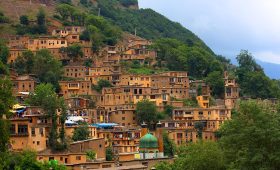Lat Caravanserai: A Historical Gem in the Heart of Gilan
Lat Caravanserai, also known as the Shah Abbasi Caravanserai, is one of the most significant historical landmarks in the Gilan Province of northern Iran. Located approximately 30 kilometers south of Rasht, the capital city of Gilan, this caravanserai holds immense historical, architectural, and cultural value. It is one of the few remaining examples of traditional Safavid-era caravanserais in the region, showcasing the rich heritage and hospitality of the Persian Empire.
Historical Background
The Lat Caravanserai was constructed during the Safavid Dynasty (1501-1736), a period marked by the expansion of trade, art, and culture across Iran. Caravanserais played a crucial role in facilitating long-distance trade and travel by providing safe and comfortable resting places for merchants, pilgrims, and travelers. This particular caravanserai was strategically located on the historic trade route connecting Rasht to Qazvin, making it an important stopover for traders traveling across northern Iran.
The caravanserai is believed to have been built under the orders of Shah Abbas I, the great Safavid ruler, known for his efforts to improve infrastructure and trade routes across the empire. Thus, the caravanserai is also referred to as Shah Abbasi Caravanserai, highlighting its royal patronage. The building’s architecture and historical context reflect the grandeur and sophistication of the Safavid era, making it an essential part of Iran’s cultural heritage.
Architectural Features
The Lat Caravanserai is a classic example of Safavid architecture, characterized by its robust and functional design. Like many other caravanserais from the period, it is designed as a large, enclosed courtyard with rooms arranged around the central space. The fortified structure was designed to provide security for travelers and merchants, offering protection from the harsh weather and potential threats during long journeys.
The caravanserai features a large central courtyard with a fountain and gardens, offering a peaceful and refreshing environment for travelers to rest. The surrounding rooms, built with durable brick and stone, were originally used for lodging, storage, and stabling animals. The high vaulted ceilings and intricate brickwork demonstrate the advanced construction techniques of the era, and the design allows for optimal ventilation and comfort for guests.
The entrance to the caravanserai is marked by a grand arch, leading visitors into the expansive courtyard. The entrance hall and doorways are decorated with traditional Persian motifs, including tilework and geometric patterns, giving the caravanserai an elegant yet functional appearance. The structure’s design reflects the practical needs of a caravanserai while also incorporating the aesthetic tastes of the Safavid period.
Cultural Significance
The Lat Caravanserai is not just an architectural marvel; it also holds deep cultural significance. As a key resting point for traders and travelers, it facilitated the exchange of goods, ideas, and cultures between the different regions of the Persian Empire. The caravanserai provided a space for merchants from Central Asia, Caucasia, and Europe to rest, eat, and exchange news, making it an important site for cross-cultural dialogue.
In addition to its role in trade, the caravanserai also played a vital part in the spread of Islamic architecture and Persian hospitality across the region. The design and layout of the caravanserai, which emphasized comfort, safety, and community, reflect the values of the time and the importance placed on welcoming travelers.
Today, Lat Caravanserai serves as a cultural heritage site, preserving the legacy of the Safavid dynasty and offering visitors a glimpse into the past. It stands as a testament to the thriving trade networks that once connected Iran to the rest of the world.
Current Role and Tourism
In recent years, the Lat Caravanserai has become an important tourist attraction in Gilan Province, drawing visitors interested in Iranian history, architecture, and culture. The caravanserai is open to tourists, offering a unique opportunity to explore the historical architecture and learn about the life of travelers in the Safavid period.
The caravanserai has also been the subject of restoration efforts, ensuring that its historic features are preserved for future generations. While maintaining its historical integrity, the caravanserai now provides a fascinating setting for cultural events, exhibitions, and performances that highlight the region’s rich traditions.
Visitors to the Lat Caravanserai can also enjoy the surrounding natural beauty of Gilan, a region known for its lush forests, rolling hills, and scenic landscapes. The area surrounding the caravanserai is perfect for outdoor activities, such as hiking, nature walks, and photography. The caravanserai’s proximity to Rasht and other important cultural sites in Gilan makes it an essential stop for tourists exploring the province.
The Local Community and Economic Impact
The presence of Lat Caravanserai has had a significant impact on the local community. The site has created economic opportunities for the people of the surrounding areas, including jobs in tourism, hospitality, and handicrafts. Local artisans sell their crafts, including traditional Persian carpets, pottery, and textiles, to visitors, offering an authentic shopping experience.
The caravanserai also supports local businesses, such as restaurants and cafes, where visitors can enjoy traditional Gilan cuisine, including dishes such as Mirza Ghasemi, Kebab Tabei, and Gilan fish. These culinary delights provide an additional layer of cultural immersion for those visiting the site.
The Lat Caravanserai is a remarkable historical and cultural landmark that embodies the spirit of Persian hospitality and the grandeur of the Safavid era. With its stunning architecture, rich history, and cultural significance, it continues to be an essential stop for those exploring the beauty and heritage of Gilan Province. Whether you’re interested in history, architecture, or simply enjoying the natural surroundings, a visit to the Lat Caravanserai offers a memorable and enriching experience.

